2015 NISSAN ALTIMA SEDAN steering
[x] Cancel search: steeringPage 16 of 441
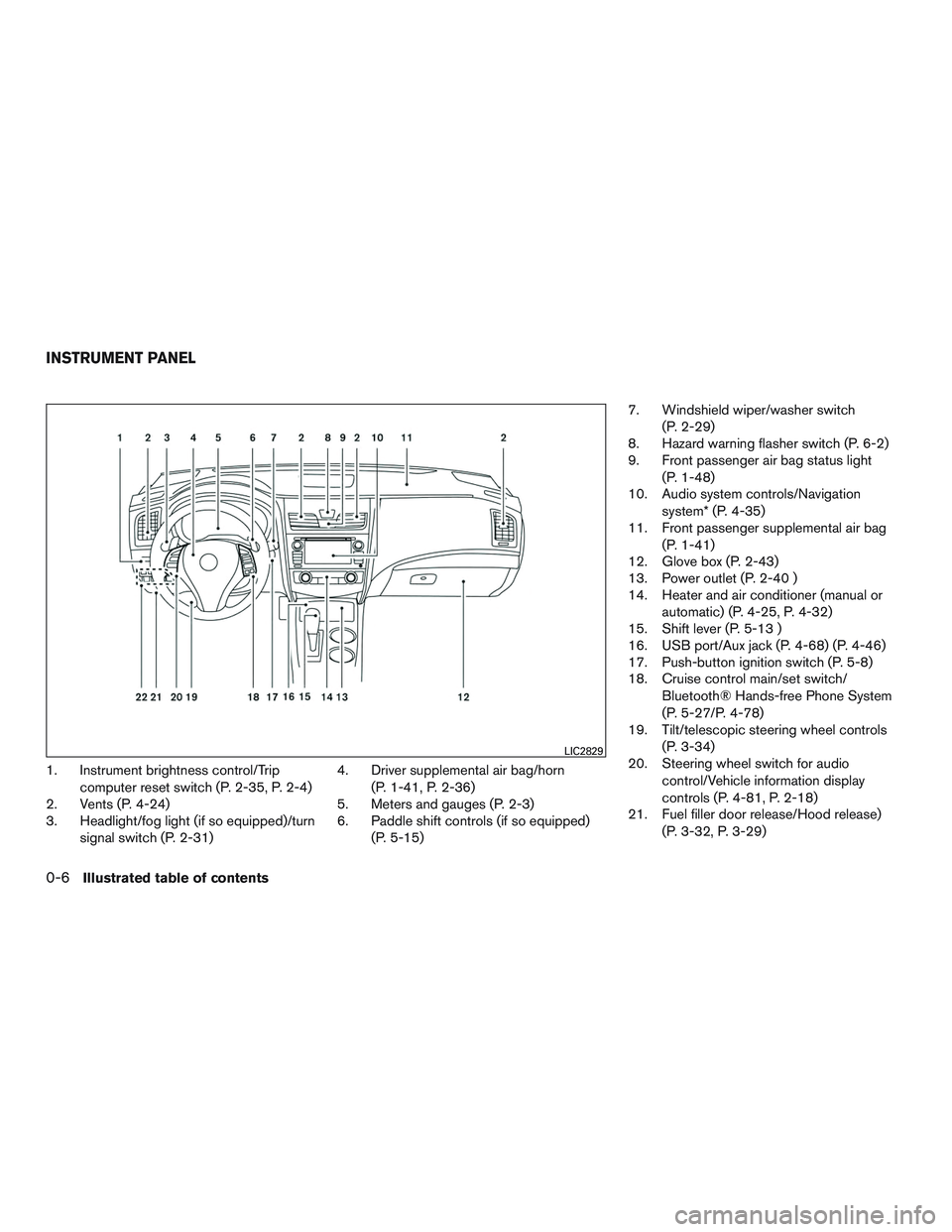
1. Instrument brightness control/Tripcomputer reset switch (P. 2-35, P. 2-4)
2. Vents (P. 4-24)
3. Headlight/fog light (if so equipped)/turn
signal switch (P. 2-31) 4. Driver supplemental air bag/horn
(P. 1-41, P. 2-36)
5. Meters and gauges (P. 2-3)
6. Paddle shift controls (if so equipped)
(P. 5-15) 7. Windshield wiper/washer switch
(P. 2-29)
8. Hazard warning flasher switch (P. 6-2)
9. Front passenger air bag status light
(P. 1-48)
10. Audio system controls/Navigation
system* (P. 4-35)
11. Front passenger supplemental air bag
(P. 1-41)
12. Glove box (P. 2-43)
13. Power outlet (P. 2-40 )
14. Heater and air conditioner (manual or
automatic) (P. 4-25, P. 4-32)
15. Shift lever (P. 5-13 )
16. USB port/Aux jack (P. 4-68) (P. 4-46)
17. Push-button ignition switch (P. 5-8)
18. Cruise control main/set switch/
Bluetooth® Hands-free Phone System
(P. 5-27/P. 4-78)
19. Tilt/telescopic steering wheel controls
(P. 3-34)
20. Steering wheel switch for audio
control/Vehicle information display
controls (P. 4-81, P. 2-18)
21. Fuel filler door release/Hood release)
(P. 3-32, P. 3-29)
LIC2829
INSTRUMENT PANEL
0-6Illustrated table of contents
Page 17 of 441

22. Vehicle Dynamic Control OFF switch(P. 2-39)
Trunk opener release switch (P. 3-30)
Heated steering wheel switch
(if so equipped) (P. 2-38)
Warning system switch
(if so equipped) (P. 2-38)
* Refer to the Navigation System Owner’s manual
(if so equipped)
See the page number indicated in paren-
theses for operating details.
Illustrated table of contents0-7
Page 18 of 441

QR25DE engine
1. Power steering fluid reservoir (P. 8-15)
2. Engine coolant reservoir (P. 8-9)
3. Engine oil filler cap (P. 8-11)
4. Brake fluid reservoir (P. 8-15)
5. Air cleaner (P. 8-21)
6. Fuse block/Fusible links (P. 8-24)
7. Battery (P. 8-17)
8. Engine oil dipstick (P. 8-11)
9. Radiator cap (P. 8-9)
10. Drive belt location (P. 8-20)
11. Windshield-washer fluid reservoir(P. 8-16)
Refer to the page number indicated in pa-
rentheses for operating details.
LDI2111
ENGINE COMPARTMENT CHECK
LOCATIONS
0-8Illustrated table of contents
Page 19 of 441
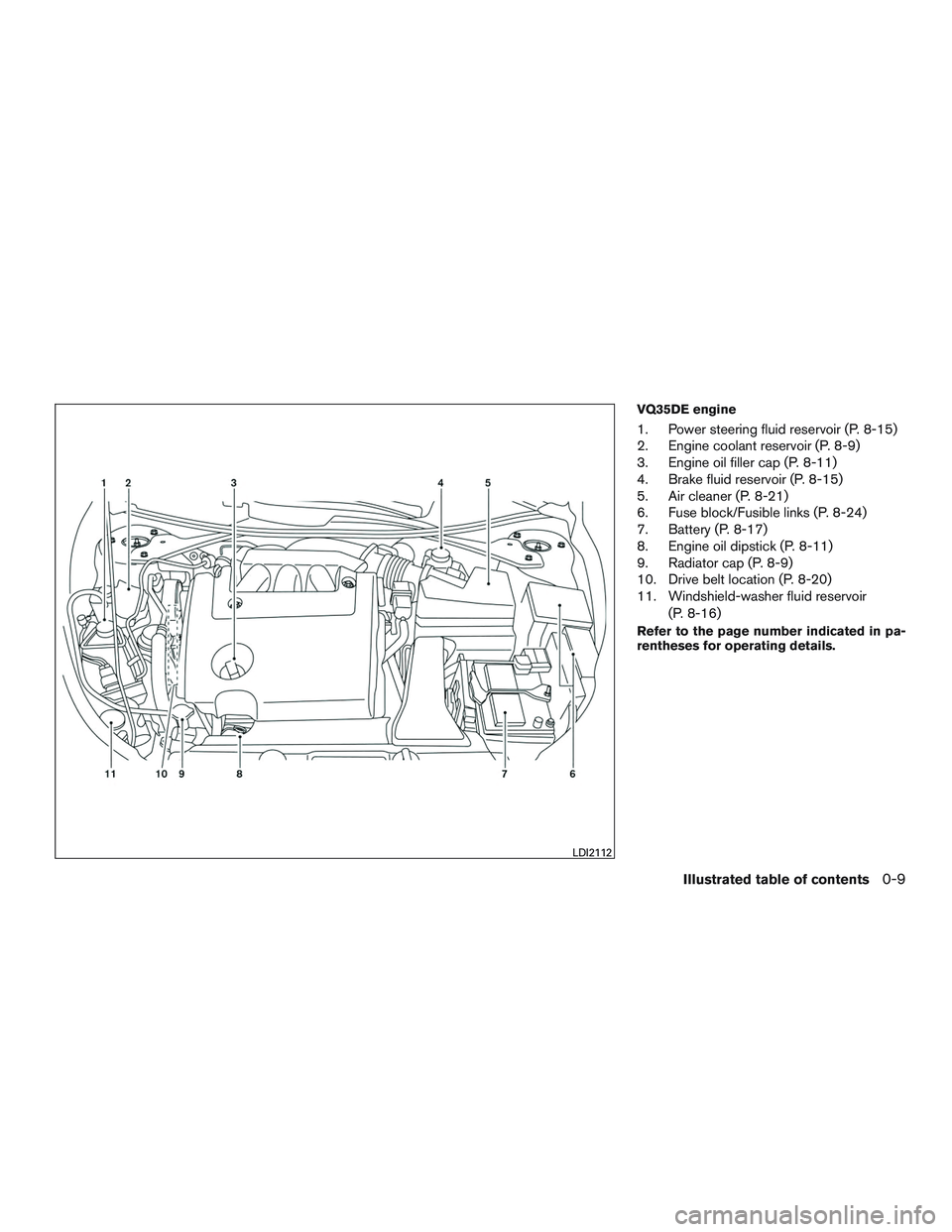
VQ35DE engine
1. Power steering fluid reservoir (P. 8-15)
2. Engine coolant reservoir (P. 8-9)
3. Engine oil filler cap (P. 8-11)
4. Brake fluid reservoir (P. 8-15)
5. Air cleaner (P. 8-21)
6. Fuse block/Fusible links (P. 8-24)
7. Battery (P. 8-17)
8. Engine oil dipstick (P. 8-11)
9. Radiator cap (P. 8-9)
10. Drive belt location (P. 8-20)
11. Windshield-washer fluid reservoir(P. 8-16)
Refer to the page number indicated in pa-
rentheses for operating details.
LDI2112
Illustrated table of contents0-9
Page 20 of 441
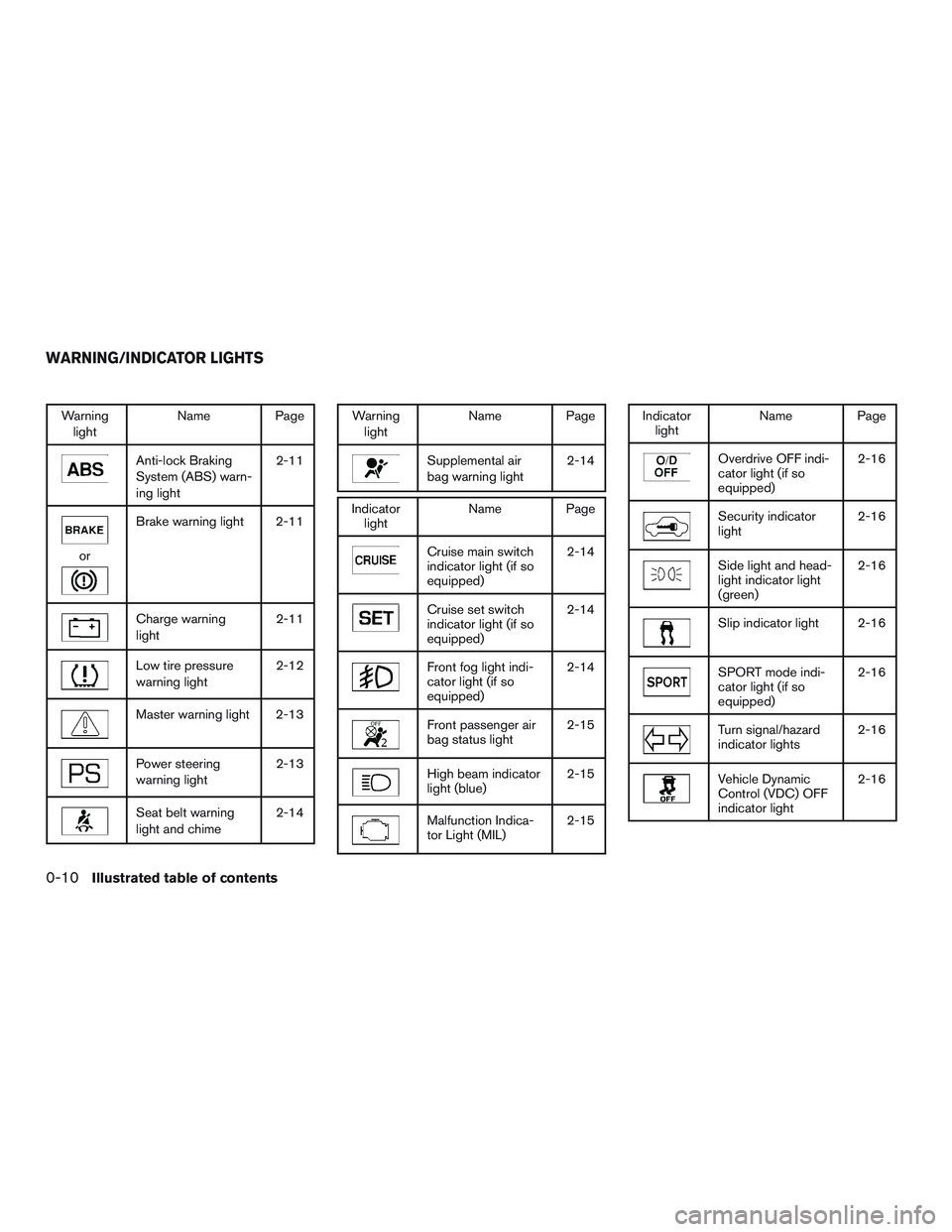
Warninglight Name Page
Anti-lock Braking
System (ABS) warn-
ing light 2-11
or
Brake warning light 2-11
Charge warning
light
2-11
Low tire pressure
warning light2-12
Master warning light 2-13
Power steering
warning light2-13
Seat belt warning
light and chime2-14
Warning
light Name Page
Supplemental air
bag warning light 2-14
Indicator
light Name Page
Cruise main switch
indicator light (if so
equipped) 2-14
Cruise set switch
indicator light (if so
equipped)2-14
Front fog light indi-
cator light (if so
equipped)2-14
Front passenger air
bag status light
2-15
High beam indicator
light (blue)2-15
Malfunction Indica-
tor Light (MIL)2-15
Indicator
light Name Page
Overdrive OFF indi-
cator light (if so
equipped) 2-16
Security indicator
light
2-16
Side light and head-
light indicator light
(green)2-16
Slip indicator light 2-16
SPORT mode indi-
cator light (if so
equipped)2-16
Turn signal/hazard
indicator lights
2-16
Vehicle Dynamic
Control (VDC) OFF
indicator light2-16
WARNING/INDICATOR LIGHTS
0-10Illustrated table of contents
Page 61 of 441
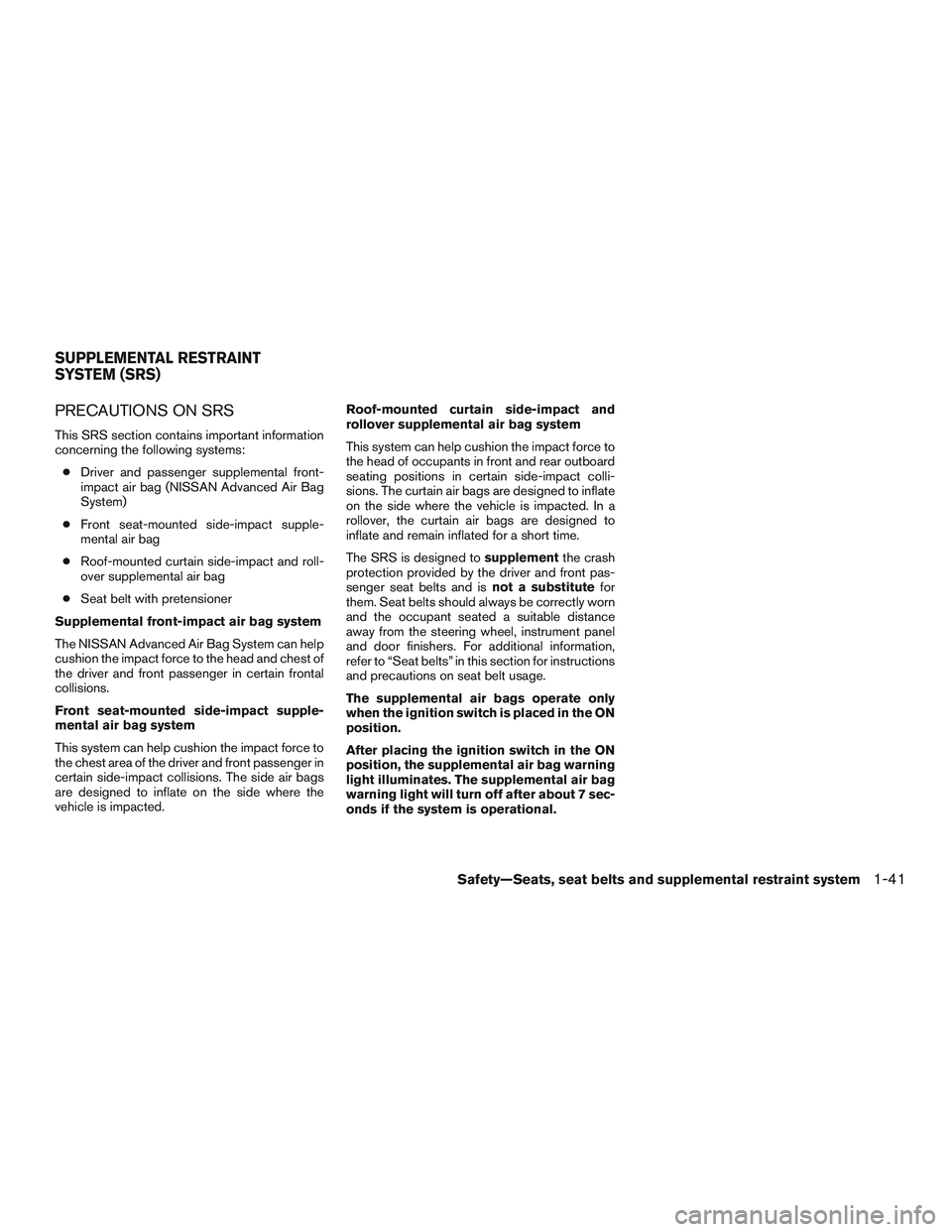
PRECAUTIONS ON SRS
This SRS section contains important information
concerning the following systems:● Driver and passenger supplemental front-
impact air bag (NISSAN Advanced Air Bag
System)
● Front seat-mounted side-impact supple-
mental air bag
● Roof-mounted curtain side-impact and roll-
over supplemental air bag
● Seat belt with pretensioner
Supplemental front-impact air bag system
The NISSAN Advanced Air Bag System can help
cushion the impact force to the head and chest of
the driver and front passenger in certain frontal
collisions.
Front seat-mounted side-impact supple-
mental air bag system
This system can help cushion the impact force to
the chest area of the driver and front passenger in
certain side-impact collisions. The side air bags
are designed to inflate on the side where the
vehicle is impacted. Roof-mounted curtain side-impact and
rollover supplemental air bag system
This system can help cushion the impact force to
the head of occupants in front and rear outboard
seating positions in certain side-impact colli-
sions. The curtain air bags are designed to inflate
on the side where the vehicle is impacted. In a
rollover, the curtain air bags are designed to
inflate and remain inflated for a short time.
The SRS is designed to
supplementthe crash
protection provided by the driver and front pas-
senger seat belts and is not a substitutefor
them. Seat belts should always be correctly worn
and the occupant seated a suitable distance
away from the steering wheel, instrument panel
and door finishers. For additional information,
refer to “Seat belts” in this section for instructions
and precautions on seat belt usage.
The supplemental air bags operate only
when the ignition switch is placed in the ON
position.
After placing the ignition switch in the ON
position, the supplemental air bag warning
light illuminates. The supplemental air bag
warning light will turn off after about 7 sec-
onds if the system is operational.
SUPPLEMENTAL RESTRAINT
SYSTEM (SRS)
Safety—Seats, seat belts and supplemental restraint system1-41
Page 62 of 441

WARNING
●The front air bags ordinarily will not
inflate in the event of a side impact, rear
impact, rollover, or lower severity fron-
tal collision. Always wear your seat
belts to help reduce the risk or severity
of injury in various kinds of accidents.
● The front passenger air bag will not
inflate if the passenger air bag status
light is lit or if the front passenger seat
is unoccupied. For additional informa-
tion, refer to “Front passenger air bag
and status light” in this section. ●
The seat belts and the front air bags are
most effective when you are sitting well
back and upright in the seat. The front
air bags inflate with great force. Even
with the NISSAN Advanced Air Bag Sys-
tem, if you are unrestrained, leaning
forward, sitting sideways or out of posi-
tion in any way, you are at greater risk of
injury or death in a crash. You may also
receive serious or fatal injuries from the
front air bag if you are up against it
when it inflates. Always sit back against
the seatback and as far away as practi-
cal from the steering wheel or instru-
ment panel. Always use the seat belts. ●
The driver and front passenger seat belt
buckles are equipped with sensors that
detect if the seat belts are fastened. The
Advanced Air Bag System monitors the
severity of a collision and seat belt us-
age then inflates the air bags as
needed. Failure to properly wear seat
belts can increase the risk or severity of
injury in an accident.
● The front passenger seat is equipped
with an Occupant Classification Sensor
(weight sensor) that turns the front pas-
senger air bag OFF under some condi-
tions. This sensor is only used in this
seat. Failure to be properly seated and
wearing the seat belt can increase the
risk or severity of injury in an accident.
For additional information, refer to
“Front passenger air bag and status
light” in this section.
● Keep hands on the outside of the steer-
ing wheel. Placing them inside the
steering wheel rim could increase the
risk that they are injured when the front
air bag inflates.
WRS0031
1-42Safety—Seats, seat belts and supplemental restraint system
Page 69 of 441
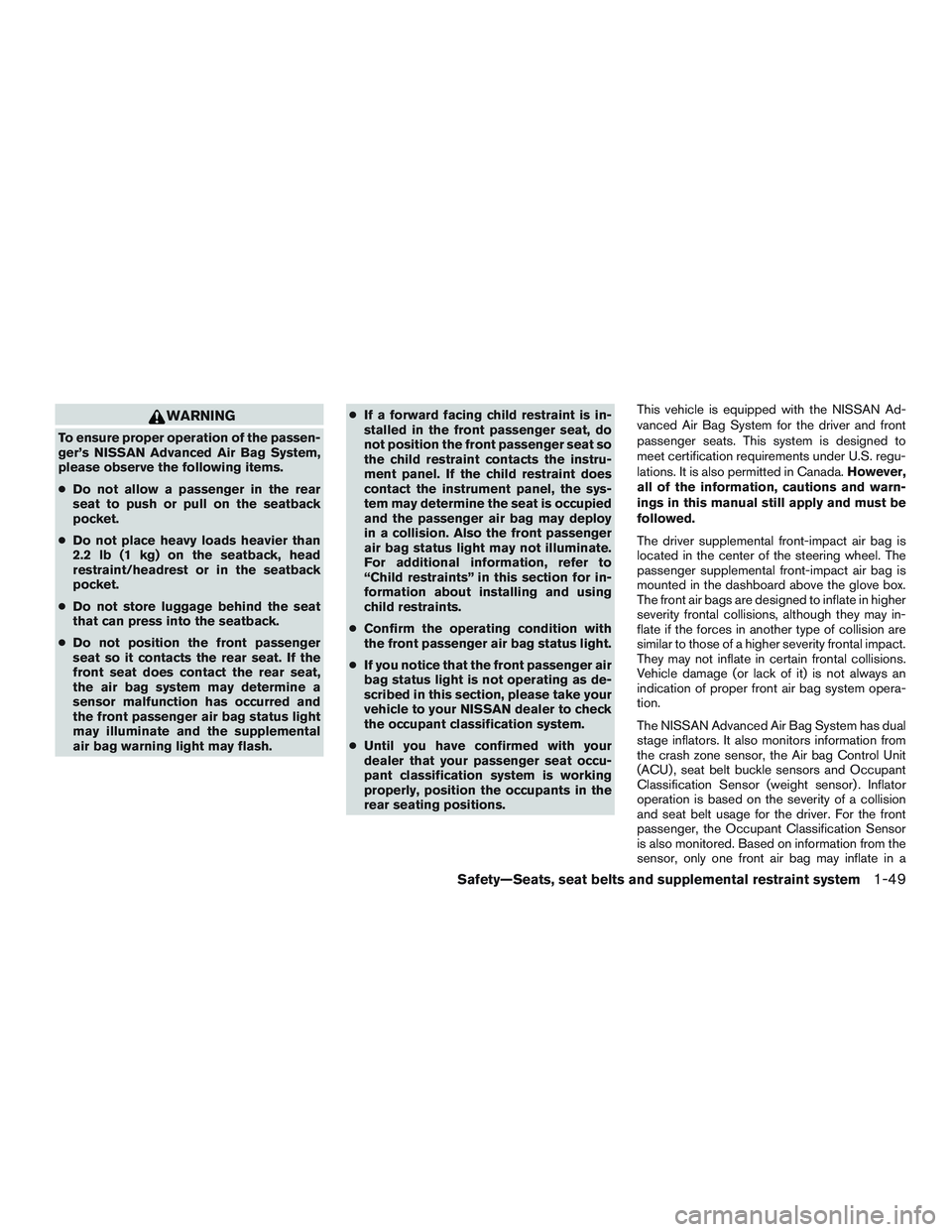
WARNING
To ensure proper operation of the passen-
ger’s NISSAN Advanced Air Bag System,
please observe the following items.
●Do not allow a passenger in the rear
seat to push or pull on the seatback
pocket.
● Do not place heavy loads heavier than
2.2 lb (1 kg) on the seatback, head
restraint/headrest or in the seatback
pocket.
● Do not store luggage behind the seat
that can press into the seatback.
● Do not position the front passenger
seat so it contacts the rear seat. If the
front seat does contact the rear seat,
the air bag system may determine a
sensor malfunction has occurred and
the front passenger air bag status light
may illuminate and the supplemental
air bag warning light may flash. ●
If a forward facing child restraint is in-
stalled in the front passenger seat, do
not position the front passenger seat so
the child restraint contacts the instru-
ment panel. If the child restraint does
contact the instrument panel, the sys-
tem may determine the seat is occupied
and the passenger air bag may deploy
in a collision. Also the front passenger
air bag status light may not illuminate.
For additional information, refer to
“Child restraints” in this section for in-
formation about installing and using
child restraints.
● Confirm the operating condition with
the front passenger air bag status light.
● If you notice that the front passenger air
bag status light is not operating as de-
scribed in this section, please take your
vehicle to your NISSAN dealer to check
the occupant classification system.
● Until you have confirmed with your
dealer that your passenger seat occu-
pant classification system is working
properly, position the occupants in the
rear seating positions. This vehicle is equipped with the NISSAN Ad-
vanced Air Bag System for the driver and front
passenger seats. This system is designed to
meet certification requirements under U.S. regu-
lations. It is also permitted in Canada.
However,
all of the information, cautions and warn-
ings in this manual still apply and must be
followed.
The driver supplemental front-impact air bag is
located in the center of the steering wheel. The
passenger supplemental front-impact air bag is
mounted in the dashboard above the glove box.
The front air bags are designed to inflate in higher
severity frontal collisions, although they may in-
flate if the forces in another type of collision are
similar to those of a higher severity frontal impact.
They may not inflate in certain frontal collisions.
Vehicle damage (or lack of it) is not always an
indication of proper front air bag system opera-
tion.
The NISSAN Advanced Air Bag System has dual
stage inflators. It also monitors information from
the crash zone sensor, the Air bag Control Unit
(ACU) , seat belt buckle sensors and Occupant
Classification Sensor (weight sensor) . Inflator
operation is based on the severity of a collision
and seat belt usage for the driver. For the front
passenger, the Occupant Classification Sensor
is also monitored. Based on information from the
sensor, only one front air bag may inflate in a
Safety—Seats, seat belts and supplemental restraint system1-49